ISSN ONLINE(2319-8753)PRINT(2347-6710)
ISSN ONLINE(2319-8753)PRINT(2347-6710)
|
Guruprasad.B.S1, Arun.L.R2, Mohan.K3 Department of Mechanical Engineering, The Oxford College of Engineering, Bangalore, India1,2,3 |
| Related article at Pubmed, Scholar Google |
Visit for more related articles at International Journal of Innovative Research in Science, Engineering and Technology
Rear axle housing supports parts rear axle assembly like rear axle shaft, differential gear assembly. It also acts as a tank for the rear end lubricants. Due to the increase in fuel cost and it is acceptable to produce a component with less weight and more life. Hence there is a urge for light weight and prolonged life of the automobile components. In order to achieve this hybrid aluminium composite (Reinforced with Al2O3 and Fly ash ). It is observed experimentally that the reinforced aluminium with Fly ash and Al2O3 enhances mechanical properties in comparison with monolithic metal. In present work with the use of finite element analysis factor of safety for rear axle housing is estimated for both hybrid composite and monolithic metal. In comparison with the results found for hybrid composite metal and monolithic metal, composite material analysis results were found to be better than the monolithic metal.
Keywords |
| Rear axle, Aluminium hybrid composites, Al2O3, Fly ash |
INTRODUCTION |
| Image Rear axle housing contains and supports other parts of the rear axle assembly like rear axle shaft, differential gear assembly. It also acts as a tank for the rear end lubricants. The housing consists of suspension system attachment. Most rear axle housings also support the stationary parts of the rear brake assemblies. The rear axle housing associated with solid axle rear suspension consists of central housing, axle tubes and differential unit. Most of the rear axle housings are made out of steel. The rear axle housing is a solid structure, it moves up and down along with the wheels as they move over uneven profiled roads. They are two type of rear axle housing are single piece type and split piece or banjo type. The split piece or banjo type of housings will be used in heavy vehicles like trucks. The rear axle housing is shown in Fig |
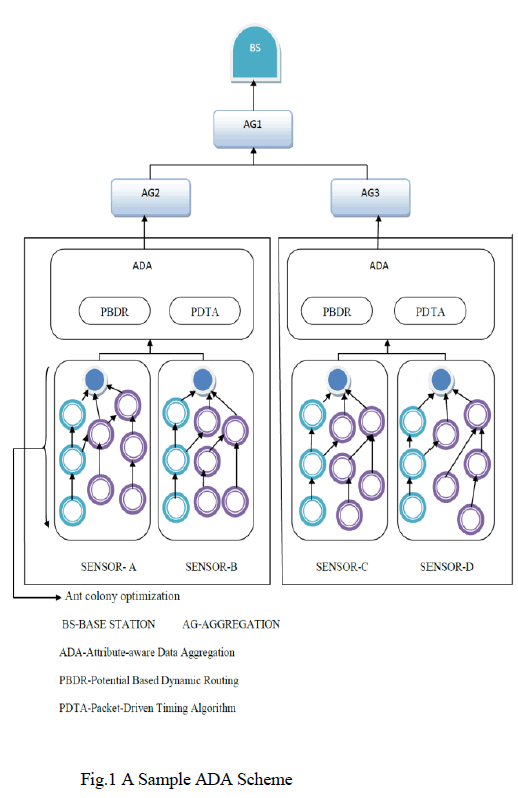 |
| The basic functions of the rear axle housing is |
| Support the vertical loads exciting from the rough road. |
| Houses and covers axle shaft, differential gears |
| Keeps the lubricants inside the housing. |
| Supports steering cylinder when used. |
| Meng Qinghua et al [1] analyzed for fatigue failure of truck rear axle housing excited by random load distribution from the uneven road profile. During operation of the truck the random load acts on the axle housing in vertical direction causes severe impact on the fatigue life of the components, By using random load distribution data the fatigue life of the truck is analyzed and also design optimization is proposed to increase the fatigue life of the components according to the simulation results and location of failure. G Rajesh Babu et al [2] carried out the static and dynamic analysis of banjo type rear axle housing by using FE method for two different materials like cast iron and mild steel. The induced deformation in cast iron housing is greater than mild steel housing and also the natural frequencies of the cast iron are lower than the mild steel. Also observed that the stress induced in the cast iron is lower than the mild steel and concluded that the cast iron is preferred for production of rear axle housing. Sanjay Aloni [3] carried out the comparative study on tractor trolley axle by using FE method. The fatigue behaviour of the existing axle is analyzed and found that failing before the expected life. Further design optimization and fatigue life analysis is carried out to improve the fatigue life and to reduce the weight of axle by using finite element method. |
| Javad Taroghi et al [4] analyzed for static and dynamic behaviour of front axle housing of tractor using finite element method. In this study total weight of the vehicle and load from the field during agricultural operations is considered on the front axle housing and analyzed for static strength of the housing. Also dynamic analysis of the axle housing is carried out to find natural frequencies of the housing and suggested the design optimization to improve the static and dynamic behaviour of the front axle housing. Z Husin et al [5] carried out fatigue life evaluation of lower suspension arm when subjected to variable amplitude loading condition by using Finite element method. The variable amplitude loads were taken from Society of Automotive Engineering (SAE) for bracket, transmission and engine loads. The analysis is carried out for different aluminum alloys and suggested the optimum material for the manufacturing of the lower suspension arm. The fatigue life was estimated based on both stress life and strain life approach. Both methods satisfy in terms of fatigue life of the recommended material for lower suspension arm. H C Anil Kumar [6] et al experimentally investigated the mechanical properties of fly ash reinforced with aluminum alloy (Al 6061) composites. The Mechanical properties were investigated for different fly ash particle sizes with different reinforcement weight fraction by using stir casting technique and studied the effect of fly ash reinforcement with different weight percentage and particle size on the mechanical properties such as ultimate tensile strength, compressive strength and hardness of the composites material. Experimentally found that tensile strength, compressive strength and hardness of the composites decreases with increase in fly ash particle size and increases with increase in the weight percentage of the fly ash reinforcements. MadevaNagaral [7] et al studied the effect of aluminum oxide particle reinforcements on mechanical and wear properties of 6061 Al alloy composites by fabricating 6061Al composites with different weight percentage of Al2O3particles up to 9% by using stir casting technique and concluded that tensile strength, yield strength of the composites increases with increase in weight percentage of Al2O3 reinforcement particles. The composites having higher hardness than the 6061 Al alloy and hardness increases with increase in Al2O3 reinforcements. Author also stated that wear rate of the composites increases with increase in weight percentage of reinforcement and ductility decreases. |
| Sajjadi S A [8] et al carried out an experimental investigation of microstructure and mechanical properties of Al- Al2O3 composites. In this study A356 alloy composites is stir casted with different weight percentage of Al2O3 reinforcements and with different reinforcement particle size and stated that compressive strength, tensile strength of the composites increases with increase in weight percentage of reinforcements. And also investigated the best stir speed for uniform mixing of reinforcements and conducted several iterations with different stir speed finally claimed that stir speed of 300rpm is better for uniform mixing of reinforcements. It is observed that wettability of the reinforcement’s particles within molten matrix decreases with increase reinforcement percentage and decreases with reinforcement particle size. It also revealed that hardness and porosity of the composites increases with increase in weight percentage of reinforcement and decreases in particle size. Sudarshan, M.K. Surappa[9] et al have synthesized A356 Al–fly ash particle composites and studied mechanical properties and dry sliding wears and came into brief idea that the damping capacities of composite increases with the increase in volume fraction of fly ash. The 6% volume fraction of fly ash particles reinforced into A356 Al alloy shows low wear rates at low loads (10 and 20 N) while 12% of fly ash reinforced composites show lower wear rates compared to the unreinforced alloy in the load range 20–80 N. At higher load, subsurface de-lamination is the main mechanism in both the alloy as well in composites. The wear rate of the composite material decreases with increases in weight percentage of reinforcement particles.Some images contain mixed text-picture-graphic regions in which text characters are printed in an image. Detecting and recognizing these characters can be very important, and removing these is important in the context of removing indirect advertisements, and for aesthetic reasons. There are many applications of image inpainting ranging from restoration of photographs, films, removal of occlusions such as text, subtitle, logos, stamps, scratches, red eye removal etc. |
II. COMPARISON OF MECHANICAL PROPERTIES |
| It is observed from the comparison of results that the mechanical properties of hybrid aluminium composites is superior than the monolithic metal. |
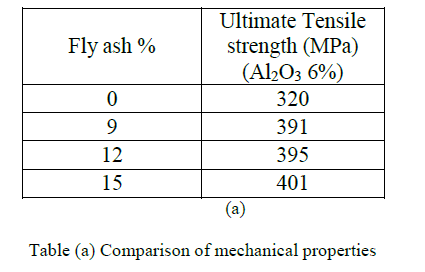 |
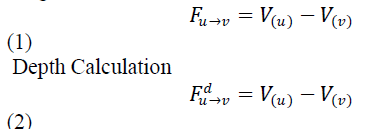 |
III. FE ANALYSIS RESULTS AND DISCUSSION |
| The finite element model for the static analysis is modeled by using Hypermesh. The geometry from the Catia software is exported into IGES/STEP format. This has been imported into Hypermesh, the de-featuring operation is carried out to remove small diameter bolt holes, fillets etc. The whole model is meshed with Second order tetrahedral elements with 30000 elements and 103301 nodes.The FE model is imported in ANSYS window and verified for elemental quality, material assignment and element type. The boundary conditions and loading details are applied in ansys. Then the analysis type is selected and solved for the given loading and BCs. After solving the model, output results such as von-Mises stress, major principle stress, and minimum principle stress and deformation plots are extracted. The modified good man equation is used to calculate the fatigue factor of safety. |
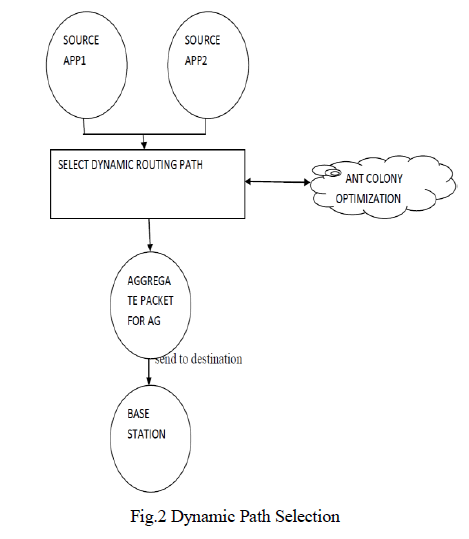 |
IV. BOUNDARY CONDITION |
| The both end of rear axle housing is connected to the wheel mounting hub, hence there will not be any relative motion between the housing and wheel hub. Hence both the ends of the rear axle are fixed in all degrees of freedom. So that rear axle housing acts as a simply supported beam. Fig (e) &(f) shows the constraint in all DOF. |
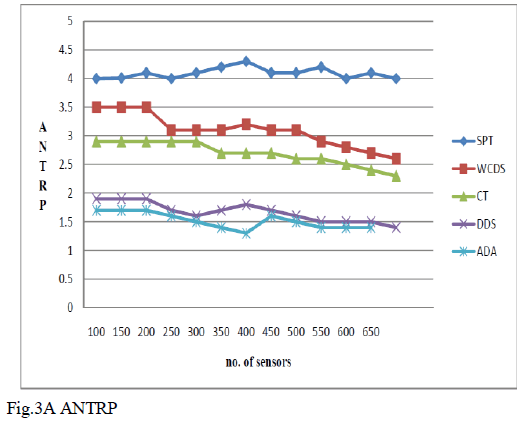 |
| The static structural analysis is carried out for a spring reaction force of 25000 N is applied at spring mounting location fig (e) and model is constrained at the wheel hub mounting location fig (f). The von-mises stress induced in the rear axle housing is found to be 391.53 MPa, which is 78.69% of the yielding strength of the material, hence the housing satisfies the safety conditions for maximum load. The maximum stress location found by analysis is same as actual test failure location [19]. The stress contours are shown in Fig . |
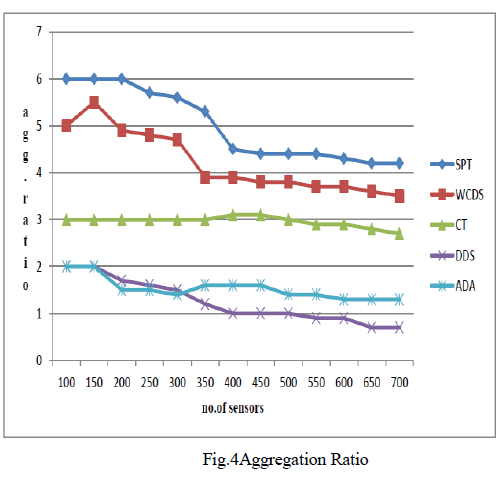 |
| Fig (g) Maximum von-mises stress Fig (h) displacement contours |
| TRANSIENT STRUCTURAL ANALYSIS OF REAR AXLE HOUSING |
| During the initial stages of design, it is assumed that the loads are acting statically and constant. But in reality this assumption does not holds good for many mechanical structures. Hence to account the variation in loads acting on the mechanical structures, the transient or dynamic analysis will be carried out. In the transient analysis the loads are changing with respect to time of operation of a part. The fatigue factor of safety is calculated for constant amplitude load varied from 1820 N to 91000 N. The fatigue factor of safety is calculated for fatigue strength corresponds to 8e5 cycles. |
| The rear axle housing is subjected to a dynamic loading during its operation, even though the dynamic stress levels are lesser than the allowable yield limit of the material leads to a failure after repetition of some number of cycles. This cyclic failure phenomenon is called fatigue failure. The fatigue life estimation is carried out for a given loading condition. |
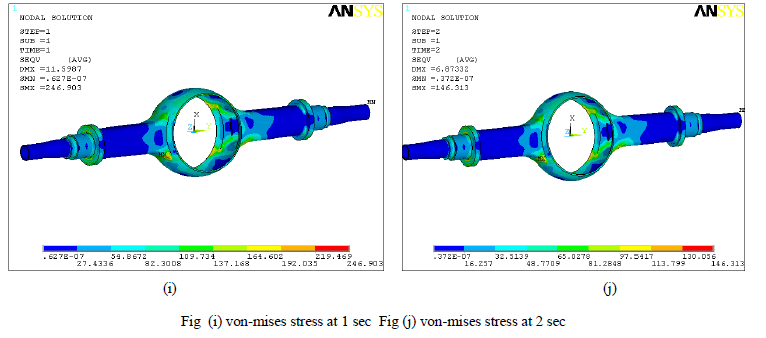 |
V. RESULTS AND DISCUSSION |
| FACTOR OF SAFETY FOR MAXIMUM LOADING CONDITION |
| The factor of safety for different materials is shown in the table 8.11. The highest reinforcement material is having more factor of safety because of more yield strength due to presence of the reinforcements in the matrix alloy. From the table 8.11 it is clear that the resistance to the deformation of the material increases with increase in reinforcement particles. The composites are showing better results compared to unreinforced alloy. Hence for static application, the composites materials can be replaced with unreinforced alloy without affecting the performance of a part. |
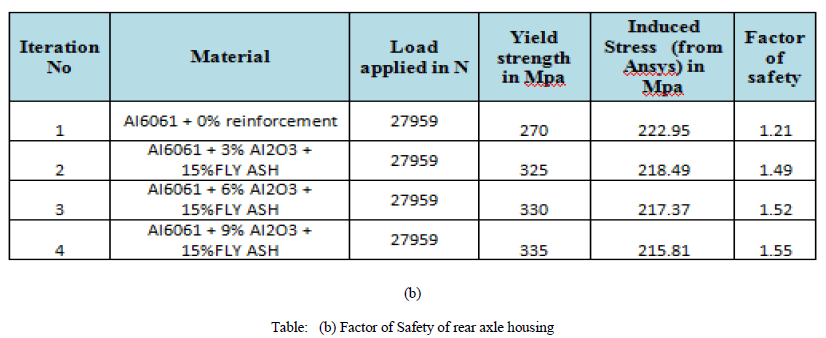 |
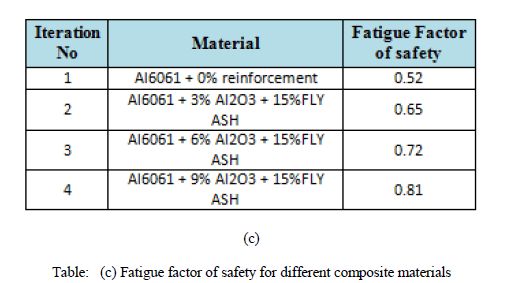 |
VI. CONCLUSION |
| the fatigue factor of safety for composites is greater than the unreinforced alloy under dynamic loading conditions.the fea results show that composite material have more safety factor for maximum loading when the load is applied statically.from the fea results it is revealed that presence of reinforcement particles improve the fatigue life and hence these composite can be used for both static and dynamic applications like connecting rod, suspension arms, springs, rear axle housing etc. |
References |
|